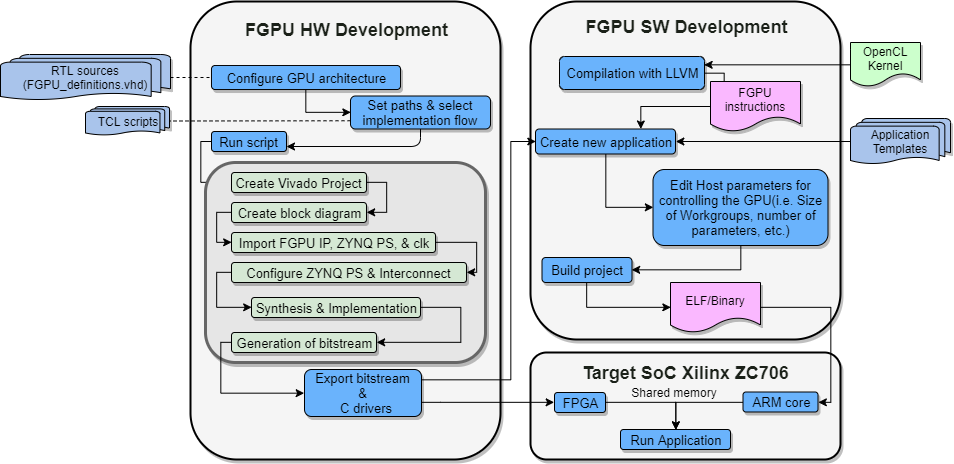FGPU is a soft GPU-like architecture for FPGAs. It is described in VHDL, fully customizable, and can be programmed using OpenCL.
FGPU is currently being developed and maintained by the Chair of Computer Engineering at the Brandenburg University of Technology Cottbus-Senftenberg, in Germany. It was originally developed by Muhammed Al Kadi from the Ruhr University Bochum, in Germany. Also, a key collaborator has been the Electronic Systems Research Group at the University of Pisa.
This repository contains the following resources:
- An RTL description of the FGPU architecture, in VHDL, which can be used for behavioral simulation and FPGA-targeted implementation -- see the RTL folder.
- An LLVM-based FGPU compiler -- see the the compiler folder.
- Files for running behavioral simulation in Mentor ModelSim -- see the project_modelsim folder.
- Files for setting up simulation and implementation projects in Xilinx Vivado.
- Pre-generated bitstreams to quickly test FGPU applications in the Zynq-7000 ZC706, skipping the HW generation step -- see the bitstreams folder.
- Examples of OpenCL kernels for execution in the FGPU -- see the kernels folder.
- Examples of complete benchmarks for execution in an ARM+FGPU processing system configured using the Vivado SDK -- see the benchmark folder.
The following figure illustrates the HW and SW flow for setting up the FGPU hardware and compiling applications.
The LLVM-based compiler will be used to generate, from an OpenCL kernel description, the binaries containing the FGPU instructions that implement the kernel. To ensure portability, the FGPU compiler is built inside a Docker container. See the instructions in see the compiler README.
The Xilinx Vivado platform will be used to generate the hardware implementation from the set of RTL files, and also necessary libraries for communicating the main processing system (an ARM core, in case of the Zynq-7000 ZC706 board). These libraries must be linked with the binaries generated in the compilation stage to enable the processing system to send commands and receive results from the FGPU. Detailed instructions for this process can be found in the README for the Vivado flow.
- The current version of the repository has been tested in both Windows and Linux.
- The implementation was tested in Xilinx Vivado v2017.2, v2019.2, v2020.2, and v2021.1.
- The simulation was tested in Mentor ModelSim 2020.1
- The VHDL code uses some VHDL-2008 constructs, which may be unsupported in some tools.
- Easily portable to other ZYNQ devices. For Ultrascale+ architecture, check branch ultrascale.
- Branch in a conditional procedure call is not working. In other words, if a branch took place, then a function is called, whose code will branch, a problem will occurr.
- Reason: A branch writes the current top entry of the diveergence stack(in CU schedulre) and will create a new entry on the top. But the overwritten entry is needed when the function returns.
- Solution: When a function is to be called, the wavefront active record (which referes to the top of divergence stack) needs to be incrmeneted. Have a look to the defined but commented PC_stack_dummy_entry in CU_scheduler.vhd.
- How to regenerate: Use the LUdecompose kernel. Make a soft floating point operation in some if. You need data without NaN of inf.
- When the buswidth of read data from cache to CUs is smaller than the #CUs * 32bit, they may be some problems. The BRAM which stores read data from the cache in each CU may be overfilled and overwritten.
- Changing the address of atomic operation within the same kernel has never been tested. Application is needed.
- Setting the number of cache banks equal or less to the number of the AXI interface banks (CACHE_N_BANKS_W <= GMEM_N_BANKS_W) may lead to a bottleneck
- Using other sections rather that .text is not yet supported.
- How to generate: Define the coeffecients of a 5x5 image filter as a 2D array constant. This data will be stored into .rodata section.
Special thanks to the Department of Information Engineering, University of Pisa for collaborating in making the FGPU more robust.
